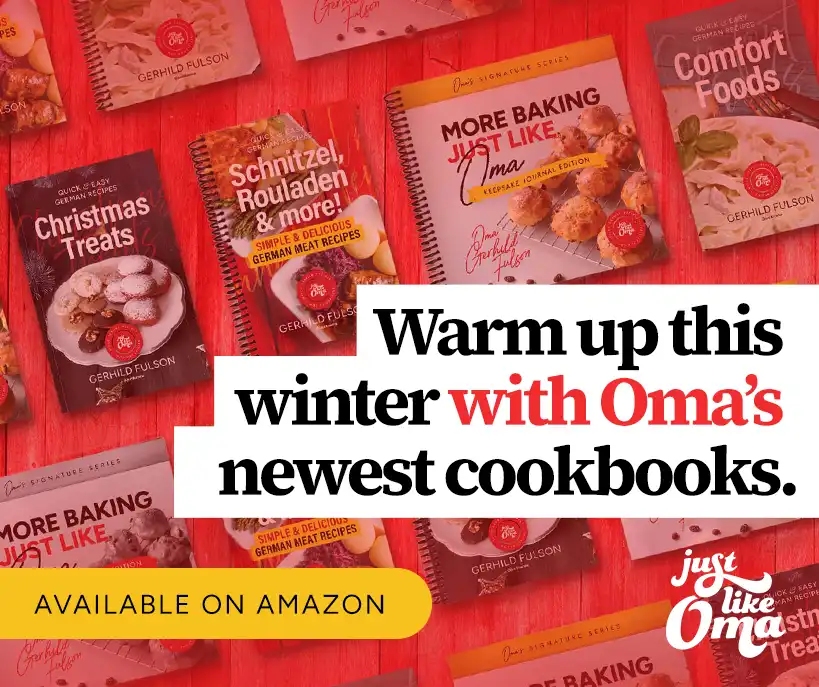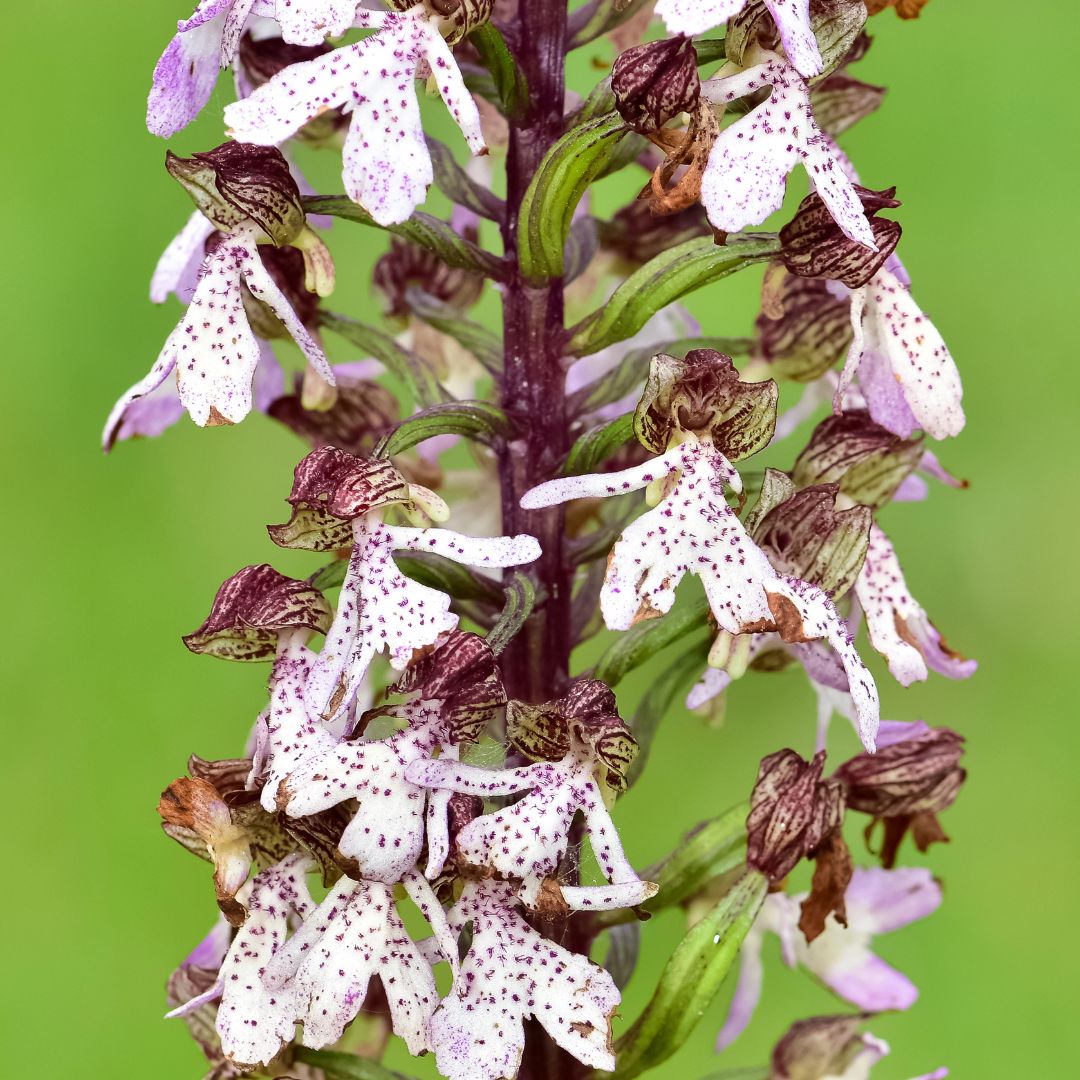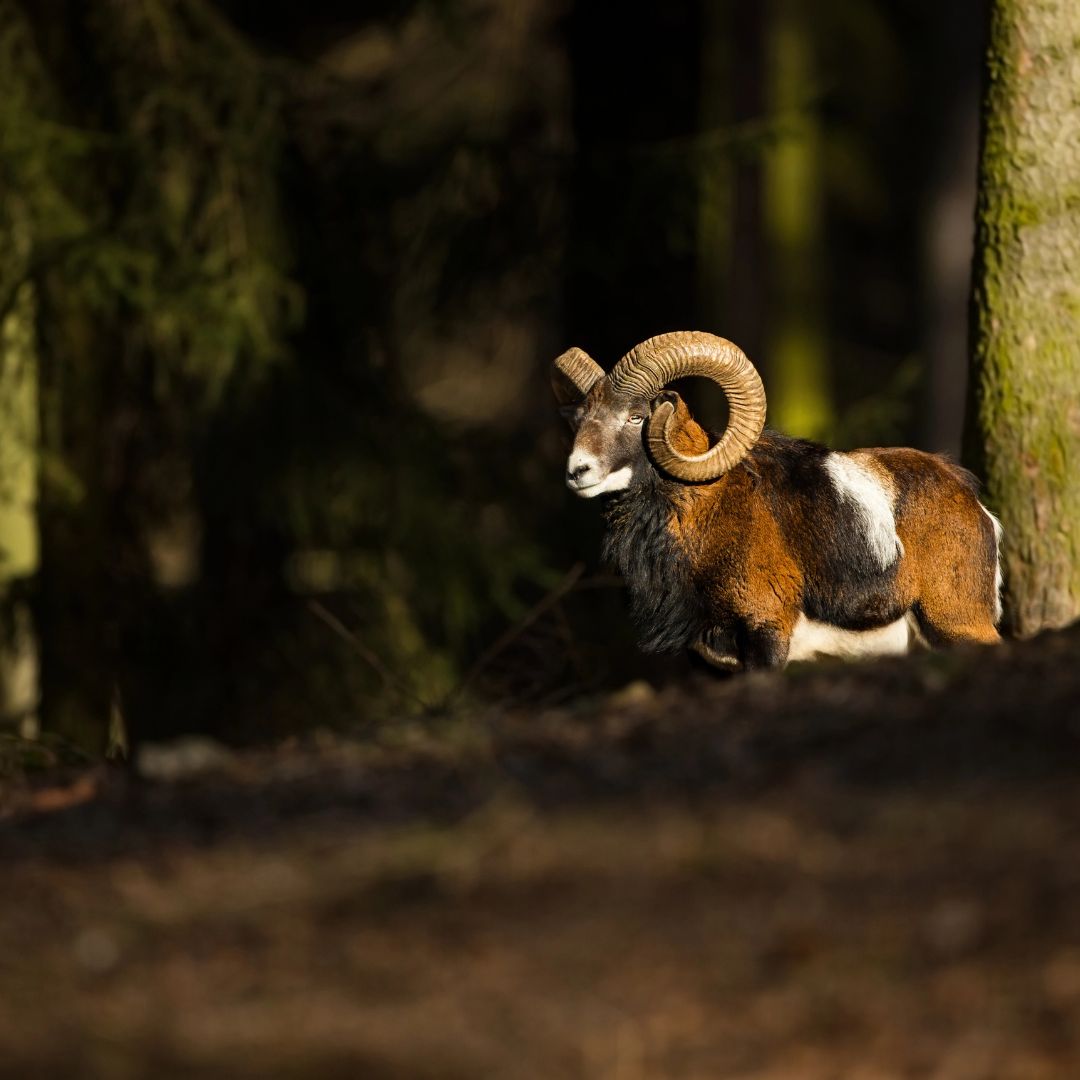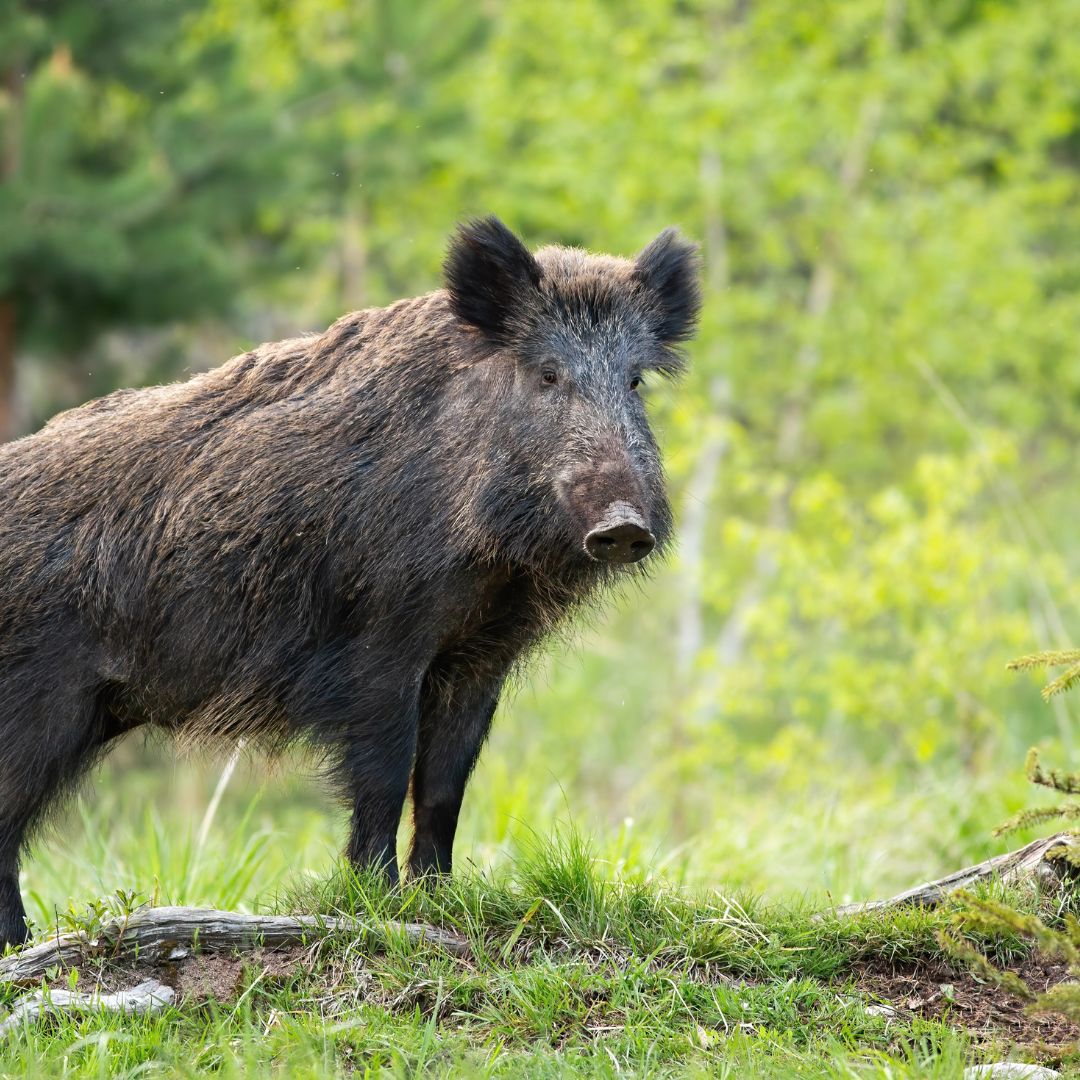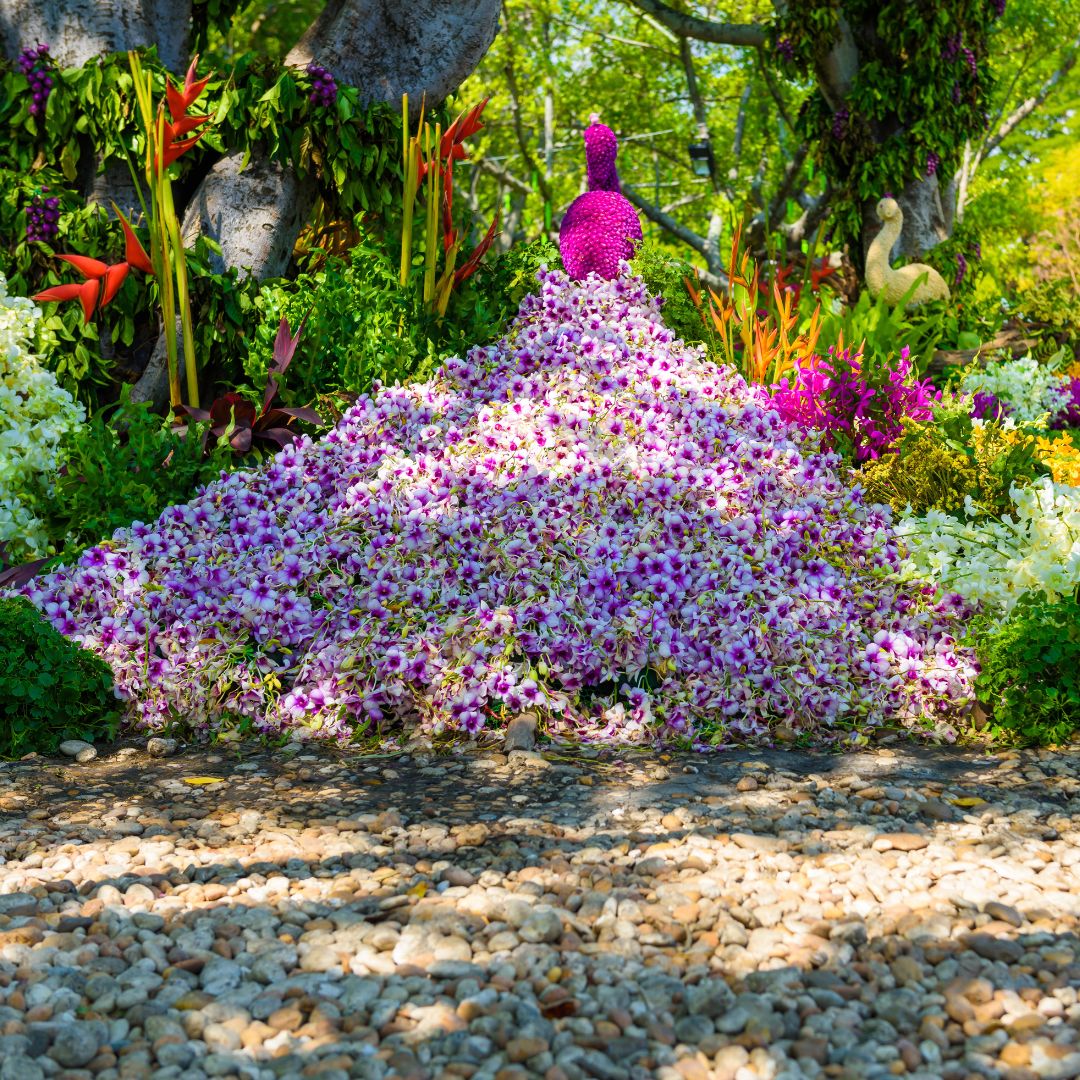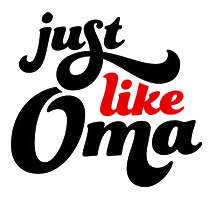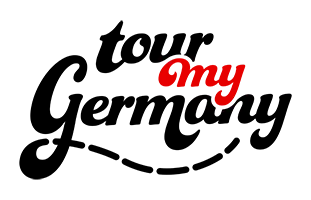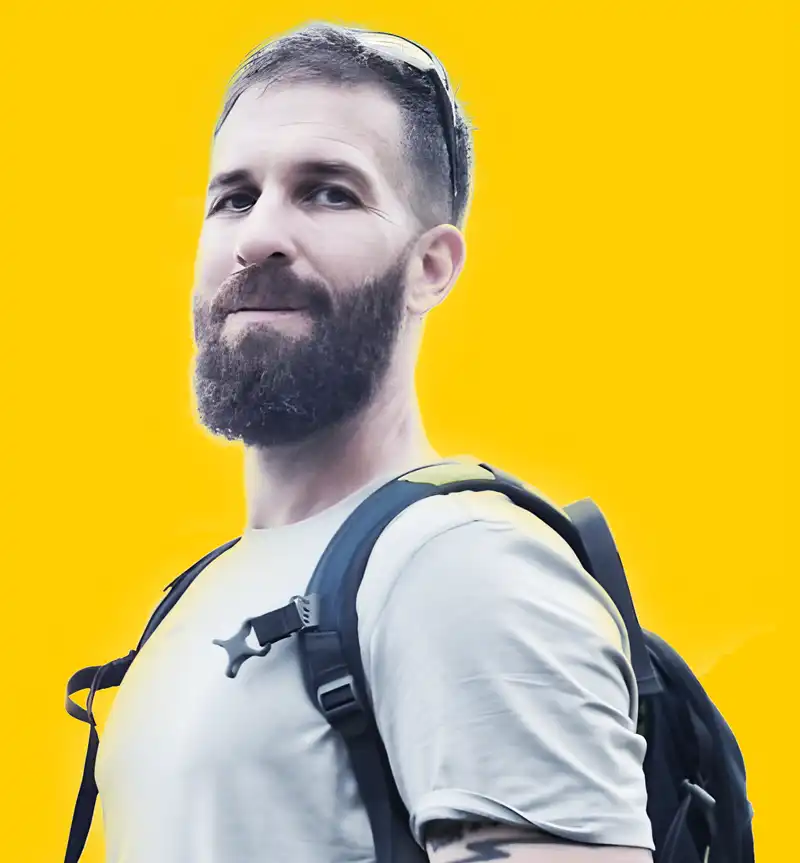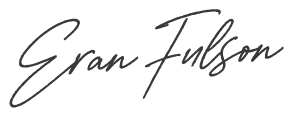Our thank you sale is on now - save 10% off any item, or 15% off two or more!
- Home
- Plants and Animals in Germany
Plants and Animals in Germany: The Flora and Fauna of the Regions
By: Lydia Fulson / Writer, Pyrography Artist, Thrill Seeker, and Traveler
Hello travelers!
It's high time we looked at the beautiful natural plants and animals in Germany, from the tiniest mushrooms to the national flowers and birds. Let's go for a walk together through the woods and see what we can see in Germany's 16 federal states.

I look forward to seeing nature on every trip that I go on. During our time in Germany, I loved seeing the beautiful wildflowers I never get to see in Canada.
On the bus tour through the winding roads, fields, and vineyards of nearly every state we drove through, I noticed mysterious, big white birds standing in the fields. And up until I did my research for this page, I finally solved the mystery! But you'll just have to keep reading to find out what it was. Maybe you already know what it was by my saying it was big and white. But as a Canadian, I had noo idea.
On this page:
Germany has such a broad range of landscapes. In the south, breathtaking mountains start to pop up, and in the north, you see the more serene coastal areas. But every region has its own unique species of mushrooms, flowers, trees, and animals—even down to the tiny rodents that scurry along the forest floors.
Curated Gallery:
What's the scientific name for "Plants/ flowers"?
What's the scientific name for "Plants/ flowers"?
The scientific name is Flora!
What's the scientific name for "Animals"?
What's the scientific name for "Animals"?
The scientific name is Fauna!
What's the scientific name for "Mushrooms"?
What's the scientific name for "Mushrooms"?
The scientific name is Funga!
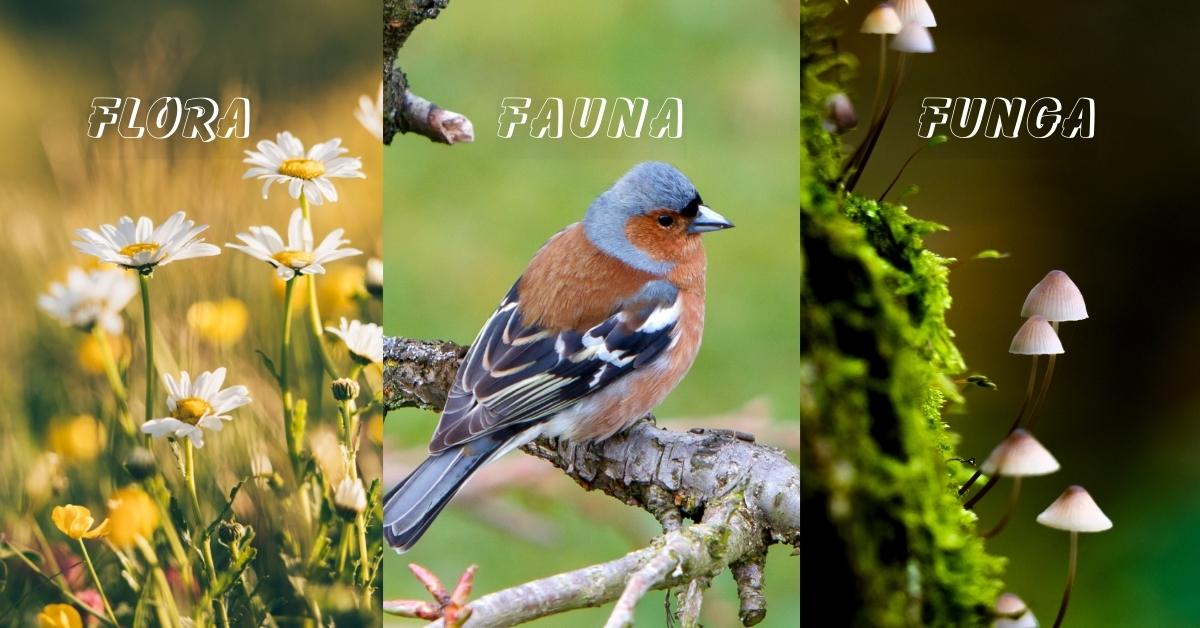
Before we jump into the individual regions, let's talk about all of the plants and animals in Germany.
Germany's Flora, Fauna and Funga
Germany's National Flower
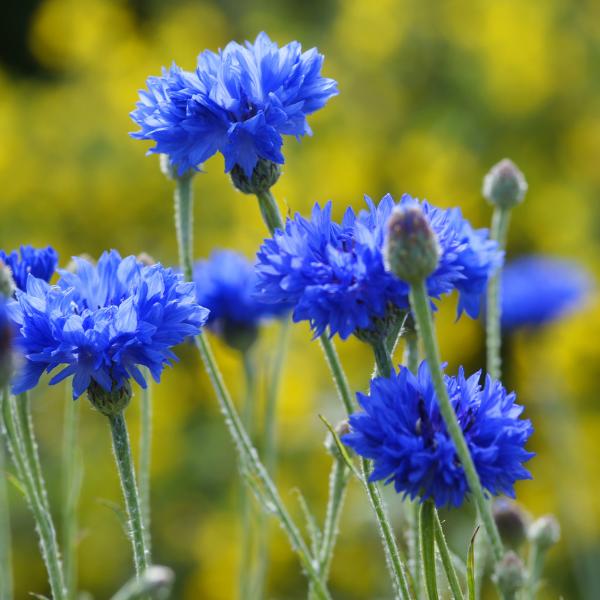 Bright, blue, and beautiful!
Bright, blue, and beautiful!The national flower of Germany is the bright and bold blue cornflower. It is a flower that can be seen throughout every region and is widespread throughout Europe and Asia.
The cornflower was worn as a symbol of patriotism on soldiers' caps in World War One. It became a flower of remembrance for the fallen, much like the poppy being Canada's symbol of remembrance.
Used and displayed in many famous German paintings and sought out as the flower of love, the cornflower gained its popularity in multiple ways through the centuries. These beautiful blue flowers are common in German forests, fields, and even on road sides.
Germany's National Tree
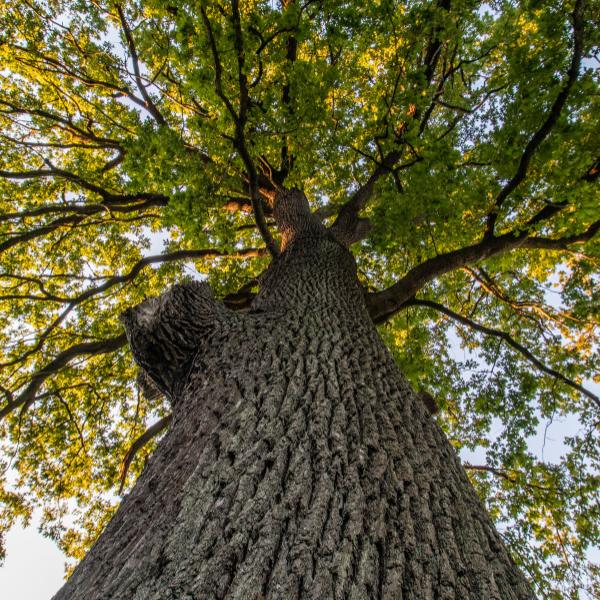 Behold: the mighty Oak!
Behold: the mighty Oak!The mighty oak has been the national tree of Germany for many centuries. It's appeared on German coins for years and is seen as a sign of wisdom and strength.
A good way to identify an oak is by its scraggly branches—they often have more than one trunk, too! The oak is THE tree species of Germany!
Germany's national animal
 Wouldn't want to get caught up in those talons!
Wouldn't want to get caught up in those talons!Eagles have been a symbol of Germany and are featured on the German coat of arms, flags, memorabilia, and banners since before the year 1000. Their strength, wisdom, and power have earned them the well-deserved title of Germany's national animal.
However, the red-tongued eagle, in particular, became the symbol of the republic after the Second War. This eagle was connected to symbolism for the Nazi Imperial Party in Germany, named the Reichsadler.
But during reunification, Germany took back the eagle as a symbol of peace, strength, and solidarity. This symbol is seen all over Germany and is called the Bundesadler.
Germany's National Mushroom
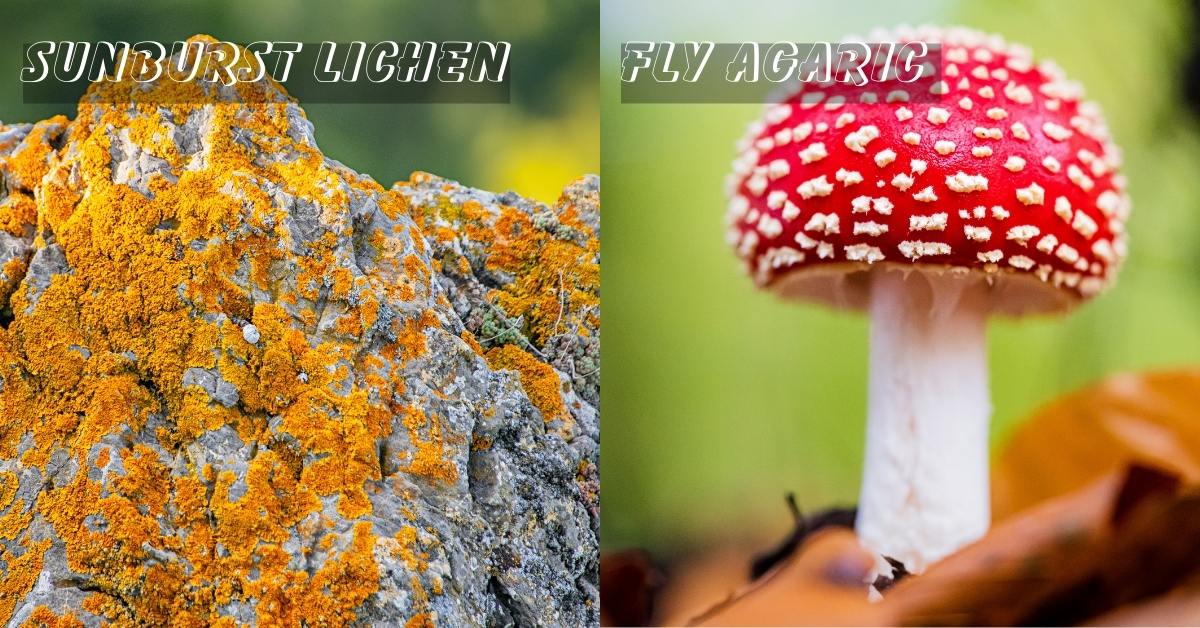 Have you seen these around?
Have you seen these around?An oddie, but a goodie! Germany has an abundance of mushrooms, ranging from beautiful and colorful to poisonous ones that can kill you with just one touch. The most common are the common sunburst lichen and the fly agaric. The sunburst lichen appears more like a moss, while the agaric is bright red and takes on that classic mushroom look.
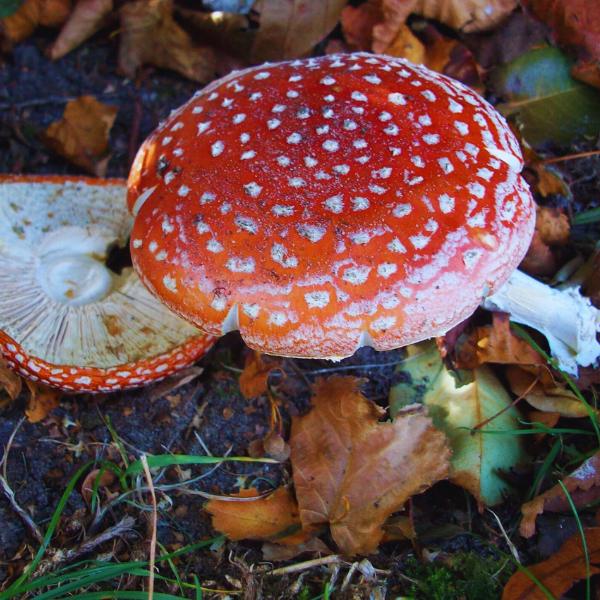 Oma found one too! She found this old mushroom picture she took and had no idea what kind it was. Now, we both know what it's called!
Oma found one too! She found this old mushroom picture she took and had no idea what kind it was. Now, we both know what it's called!Autumn is the peak foraging season in Germany. Is this something you'll be trying on your trip? After we cover our 16 states, you can find a list of edible mushrooms worth foraging for down below!
Baden-Württemberg
I grabbed this pic of the beautiful view of Heidelberg from Heidelberg Castle's lookout. Can you spot the iconic "Old Bridge"?
I know what you're thinking. "Lydia, Heidelberg isn't Baden-Württemberg..."
Actually, contraire! Baden-Württemberg is a state in Germany, meaning it's made up of multiple cities, one of which is the famous Heidelberg! Baden-Württemberg is split into thirty-five districts, with nine independent cities, including Stuttgart, Baden-Baden, and Karlsruhe.
 Looking down on Heidelberg from the gates of Heidelberg Castle up above!
Looking down on Heidelberg from the gates of Heidelberg Castle up above!Baden-Württemberg Flora
In Baden-Württemberg, the most common plant is the fagus sylvatica, the European beech. This deciduous species is known for its durable hardwood structure and graceful appearance. Due to its durability, beech is often used for furniture and instrument making.
Other common trees are dogwood trees, which attract butterflies during their beautiful blooming season. You're likely see lots of these varieties as well:
- Oak
- Sweet cherry
- Elderberry trees: Just as common as dogwood.
- English ivy: Can be found draping over old Castle walls and homes throughout the state.
- Yarrow flowers: Comes in lovely colors of pink, white, and yellow.
- Big-leaf hydrangeas
- Tulips
- Common bird's-foot trefoils are also popular finds in the floral category here.
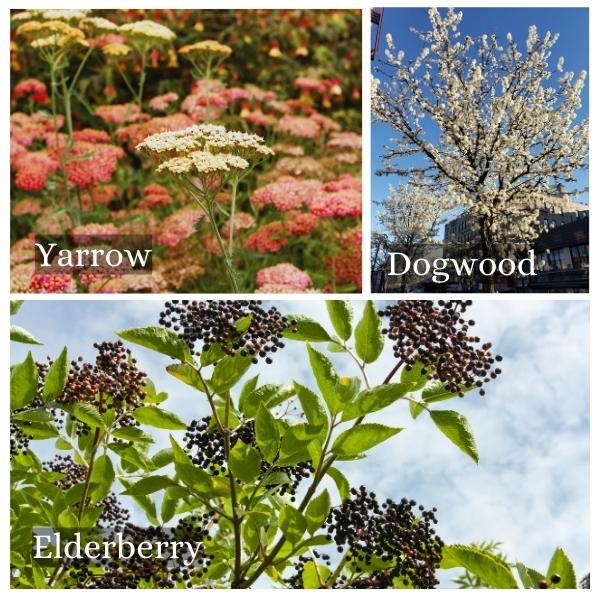
A Must-See Floral Attraction
Flowers and plants are big in Baden-Württemberg. In Konstanz, along the shimmering Lake Constance, is an island called Mainau, also known as "Flower Island."
The island is only 111 acres, and in the warmer months, when the second spring starts, the island becomes one of Germany's most popular tourist attractions. Thousands and thousands of flowers bloom on the island, creating a beautiful display of colors and scents. The island is very well maintained and is considered a conservation area.
Tulips, roses, yarrows, daisies, poppies, and loads of others, including exotic plants, flood the grounds. There are paths created for tourists to walk through the meadows, and even huge sculptures made entirely of plants.
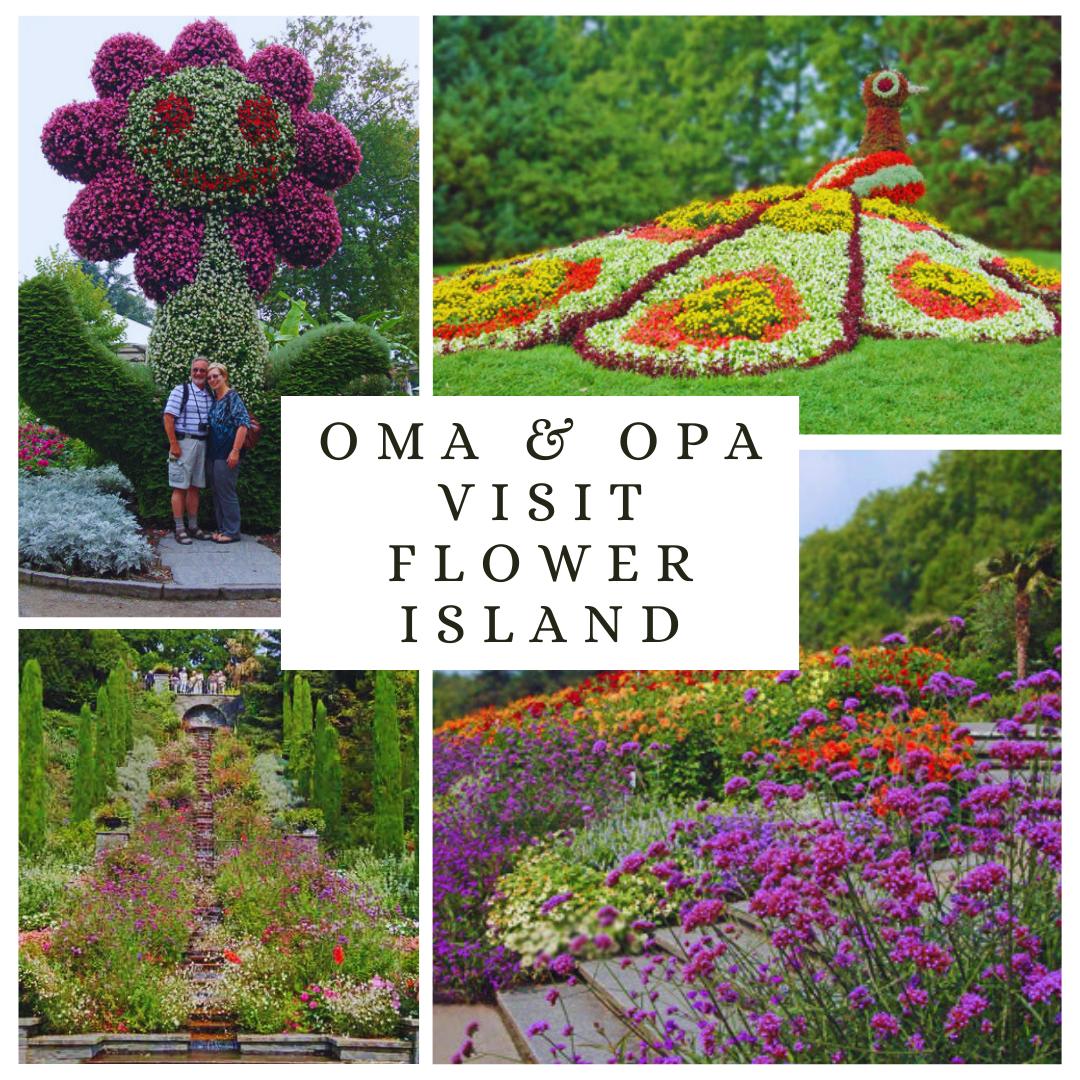 Oma and Opa visiting Flower Island on one of their amazing trips to Germany. They can speak from expereince when they say, it's worth seeing!
Oma and Opa visiting Flower Island on one of their amazing trips to Germany. They can speak from expereince when they say, it's worth seeing!Baden-Württemberg Fauna
Keep your eyes peeled for some of these common animals roaming and soaring about. Watch where you step. Hedgehogs and other small mammals may be hiding in the leaves, as well as newts and fire salamanders, which take refuge under rocks and cool, damp spaces.
Look up, and get out your bird-watching guidebook. It's not uncommon to see these in Baden-Württemberg:
- Grey heron
- Great-spotted woodpecker
- Great egret
- White swans
- A variety of geese and cormorants
Including the Canada goose—yep, confusing, I know. Well, here's a fun fact that not many people actually know. Guilty, as a Canadian, I didn't even know this myself...
Canada geese are not only found in Canada. While they breed and live in larger groups in Canada, these migratory birds were brought into Europe in the 17th century, starting in Britain. Now, they're considered a near-invasive species!
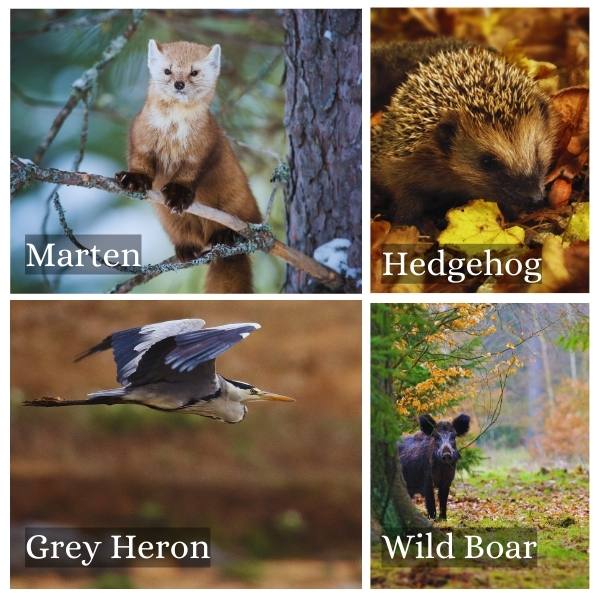
You'll also see these common mammals, species of birds, and reptiles:
- Roe deer
- Red fox
- Bicolored shrew
- European badger
- Marten
- Wild boar
- Wall lizard
- Barred grass snake
Baden-Württemberg Funga
Baden-Württemberg of Southwestern Germany is abundant in mushrooms, especially since it is situated along the black forest; fungi thrive here. Be on the lookout for:
- Lichen, especially orange lichen
- Red belted conk
- Porcini
- Turkey tail
- Parasol
- Shaggy mane
- Fly agaric

Bavaria
I got this picture during our bus ride past the Bavarian Alps on our way to Neuschwanstein Castle. I've never seen such a breathtaking view. These winding roads, with the mountainscape popping up in the background, went on for miles. Oma and I were clever in picking our spot on the bus so that we'd have a front-row seat for these views.
 These pictures give me goosebumps every time I look back through my camera roll. I love mountains! (Just ignore whatever that is smeared on the bus windshield...)
These pictures give me goosebumps every time I look back through my camera roll. I love mountains! (Just ignore whatever that is smeared on the bus windshield...)Bavaria is the perfect state for nature to thrive. Its mountainous landscape features rich, dense forests, alpine meadows, and mountain streams. As you can see on the side of the road in the picture above, there are lovely purple flowers scattered about. What are they? Keep reading to find out!
Bavarian Flora
Similarly to Baden-Württemberg, one of the most common is the beech tree, but a close top spot holder is the spruce tree. They're not as common in the higher-altitude spots but are abundant throughout the forests.
These flowers, however, thrive in the altitudes and have no problems living a great life, showing off their striking colors.
- Alpine anemone
- Alpine violets
- Edelweiss: The most common type found here.
- Red clover: These are the flora producing that bright purple tone in my photo above!
- Tasselflower
- A variety of gentians
- Alpine snowbells
- Butterbur
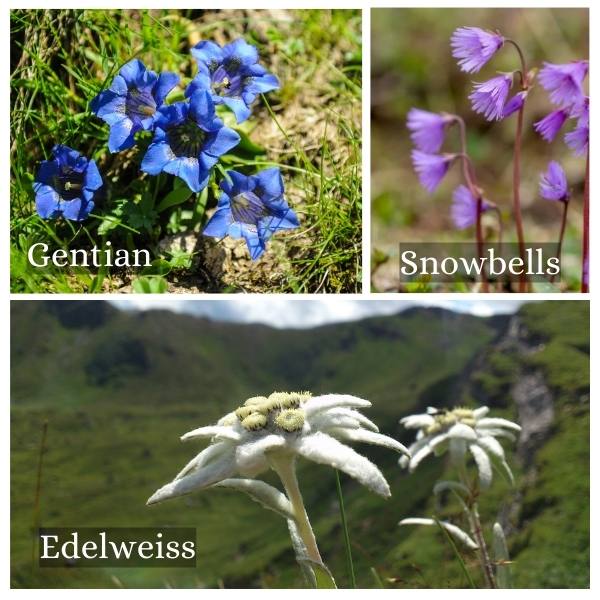
Bavarian Fauna
These flowers aren't the only thing that doesn't mind the high altitudes of this mountainous area. When you get to the Alps, be cautious. In the shadows and cracks near the mountain streams are the stealthy lynx. They used to be more commonly spotted. But better safe than sorry! It is, however, more common to see:
- Wild boar
- Fire salamander
- Alpine marmots
- Danube salmon
- Golden eagle
- White-tailed eagle
- Bearded vulture
- Ural owls
- Capercaillie
- Snow hares
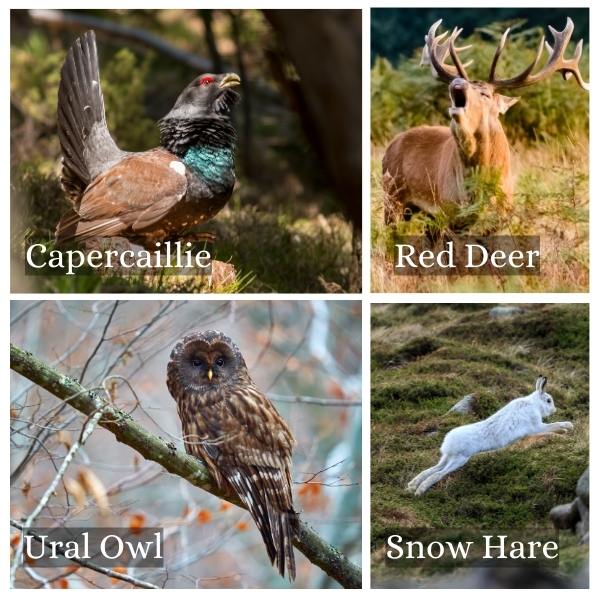
Bavarian Funga
Fungi love to climb on the fir, beech, and especially spruce trees and hide under the massive roots shooting out of the ground. The damp atmosphere is their best friend! Here are a few mushrooms that love the forests of Bavaria.
- Lemon-yellow turkey tail
- Schüpplings of all shapes and colors.
- Amethyst deceiver: named for a good reason! That bright color is so eye-catching.
- Fire sponge
- Fly agaric
- Porcini
- Common puffballs: Did you know that if you poke a puffball, it puffs out thousands of little spores from the top in a little cloud of smoke? This poke is a great way to help them reproduce, and honestly, it's pretty fun! I learned this in Thunder Bay when visiting my sister, and she showed me how they work. So nifty!
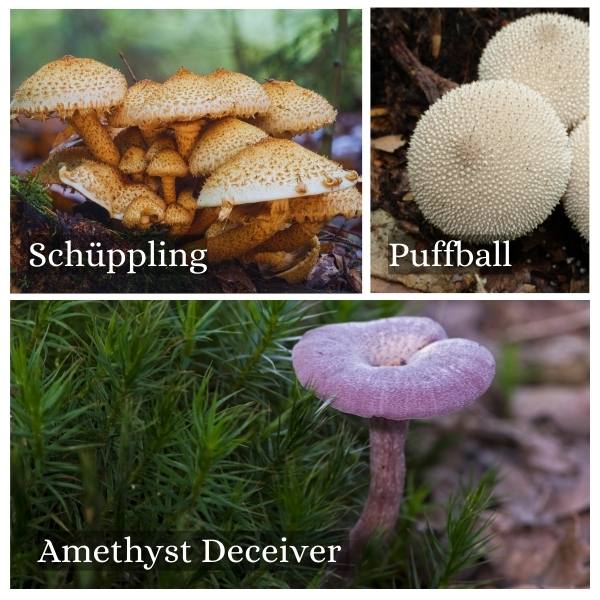
Berlin
Do you recognize this bridge? It's the Glienicke Bridge, aka the Bridge of Spies, in Berlin. This famous historical landmark was also in the Tom Hanks movie The Bridge of Spies back in 2015. I was so excited to get a picture of it and even walk across it.
 I can't believe I got to walk across the famous Glienicke!
I can't believe I got to walk across the famous Glienicke!The city-state Berlin is widely known for its big and bustling city but is rarely recognized for its green areas, like its massive Grunewald Forest. Along Berlin's forests are beaches and hiking trails aplenty.
Berlin Flora
A typical forest or green space in Berlin has sandy soil, coniferous trees, and nut-bearing plants. Some of the trees and flowers that grow there are:
- Chestnut trees
- European beech
- Birch
- Lilac
- Oak
- Viper's bugloss
- Cherry blossoms
- Hoary alyssum
- Black locust
- Lone wolfberry

Berlin Fauna
Despite its location, Berlin has a relatively diverse range of animals. Don't let the symbol of Berlin confuse you. Although the iconic Berlin bear has served as a sign of strength and protection for centuries, bears have yet to be spotted anywhere near Berlin since over 300 years ago.
But you can still spot the adorable Berlin bear statues just about everywhere in the city streets.
 Like this guy!
Like this guy!Wandering through the forests, field landscape, and parks of Berlin, one can see:
- Mouflon wild sheep
- Water buffalo: Spot these guys grazing along Lake Tegel, Berlin's second-largest lake.
- Wild boar: Spotted in forests and even crossing busy streets with a trail of piglets following behind
- Grey wolf: These are rare but spotted in large wooded areas. If you see one, report your sighting. These beautiful mammals are on the endangered list, so every sighting reported helps!
- Red fox
- Brown hare
- King fishers

Berlin Funga
Did you know that Berlin is actually a bit of a hotspot when it comes to mushroom foragers? I don't recommend picking or eating any mushrooms along your hikes in Berlin. Be sure to do research! Don't try this at home folks.
- Birch polypore
- Lobster mushroom
- Boletes
- Lungwort
- Smooth rock tripe
- Golden spindles: Related to the coral family! Don't they look like they're swaying in waves on the ocean floor?

Brandenburg
As one of Germany's least populated states, Brandenburg has a lot of space for flora, fauna, and fungi to thrive. Similar to Berlin, the soil is sandy. Brandenburg is almost entirely used for agriculture and is home to 3,000 lakes! Wow. Let's explore this state's thriving nature.
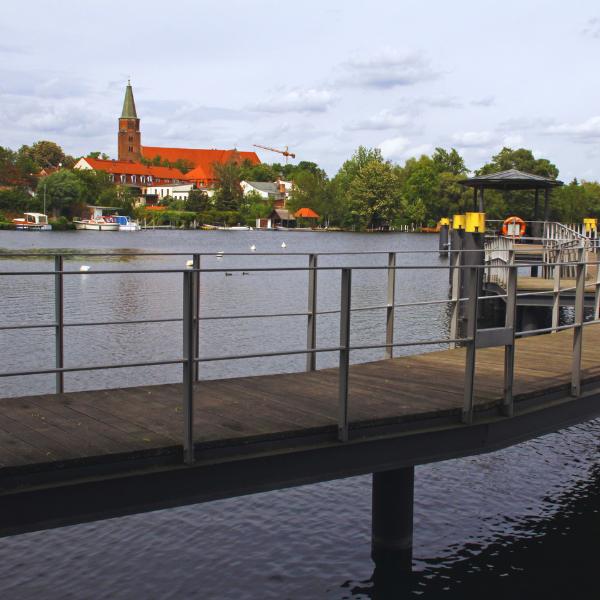 Here's just one of the 3000 lakes in Brandenburg!
Here's just one of the 3000 lakes in Brandenburg!Brandenburg Flora
- Viper's bugloss
- Greater celandine
- Tansy
- Campion
- Toadflax
- Cornflower
- Norway maple
- Fir
- Pine
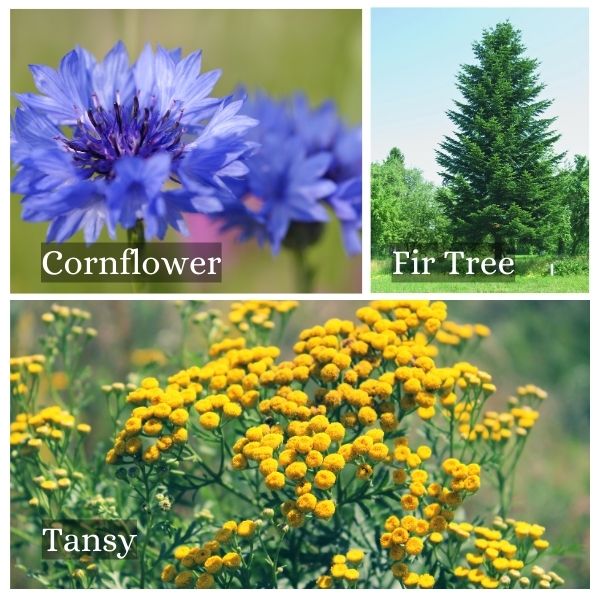
Brandenburg Fauna
One of the most common animals you'll spot in the bushes of Brandenburg is the common hedgehog moseying along tree roots. A majority of the animals inhabiting the area love the marshlands; since there are so many bodies of water, you can expect to see:
- Red deer
- Badgers
- Beaver
- Coypu: A type of Nutria, a large river-dwelling rodent, is often confused with beavers.
- Muskrat
- Stone marten
- Crane
- White storks: The mystery is solved! These are the white birds I kept spotting here and there on our tour.
- Moor frog
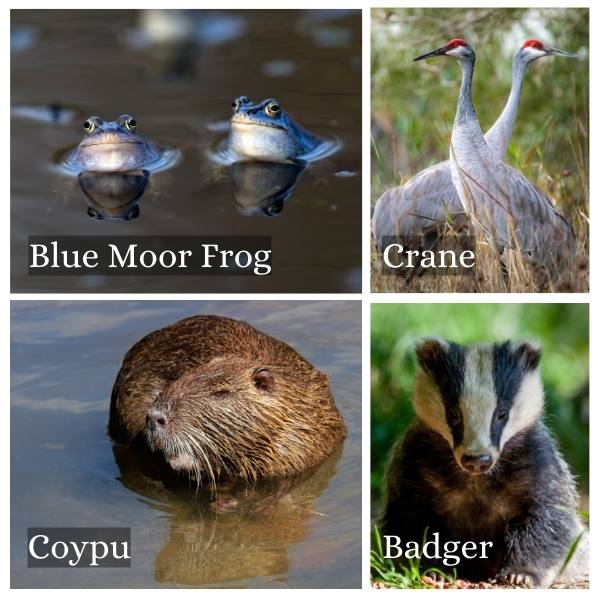
Brandenburg Funga
- Porcini
- Morels
- Chicken of the woods
- Shaggy ink cap
- Witches butter
- Lichen
- Jelly antler: Not to be confused with Golden Spindles, the Jelly Antler is distinct for its little antler-looking shoots sprouting from the top of each mushroom!
- Bolete
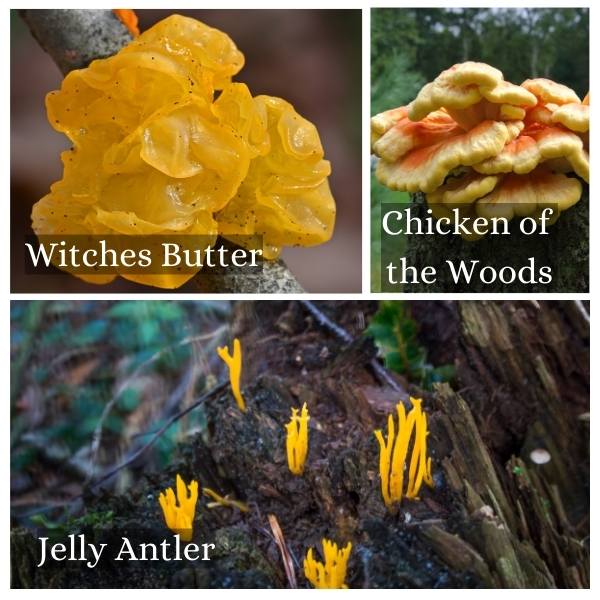
Bremen
Bremen is rich in green spaces and is home to many popular parks and nature reserves, such as the famous Knoops Park. Its closeness to the North Sea coast affects the climate drastically. It can get quite windy, causing gusts of heat and gusts of prolonged frost in the winter, affecting wildlife and nature, which can survive drastic weather changes.
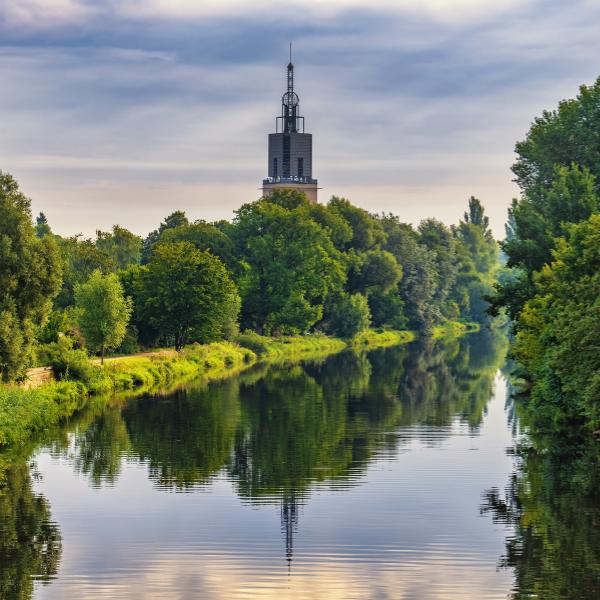 The serene beauty of Bremen's Havel River
The serene beauty of Bremen's Havel RiverBremen Flora
Along the water's edge and flooding the beautiful, well-kept parks, this is just a handful of the plants that thrive here:
- Common reeds
- Ground ivy
- Red deadnettle
- English oak
- Purple moorgrass
- Yellow iris
- Old man's beard

Bremen Fauna
Bremen has fairly common animals, but there are a few rare ones you won't see elsewhere, like the super cute harbor seal! What else can we see in Bremen?
- Eurasian stoat: Similar to a marten
- Coypu
- Red deer
- Hedgehog
- Harbor seal
- Yellow-neck field mouse
- Black-headed gull
- Eurasian coot

Bremen Funga
- Jelly ear
- Common stinkhorn: These can grow almost 30cm in a day! They are considered an invasive species in some national parks in Germany.
- Blusher
- White saddle
- Giant polypore
- Upright coral fungus
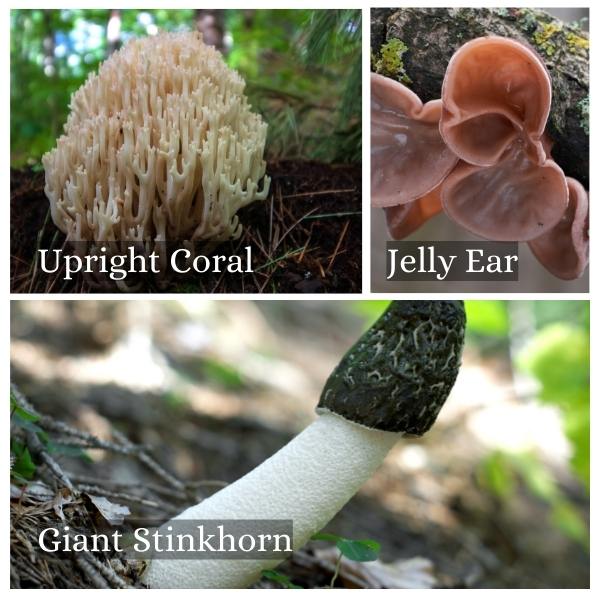
Hamburg
The coastal city-state Hamburg is nearly completely surrounded by bodies of water leading to the North Sea and the Elbe River. Hamburg is such a picturesque area. It really is like one of those stereotypical European postcards, with the colorful and bright red brick homes sitting above beautiful canals. Hamburg is the country's largest port center!
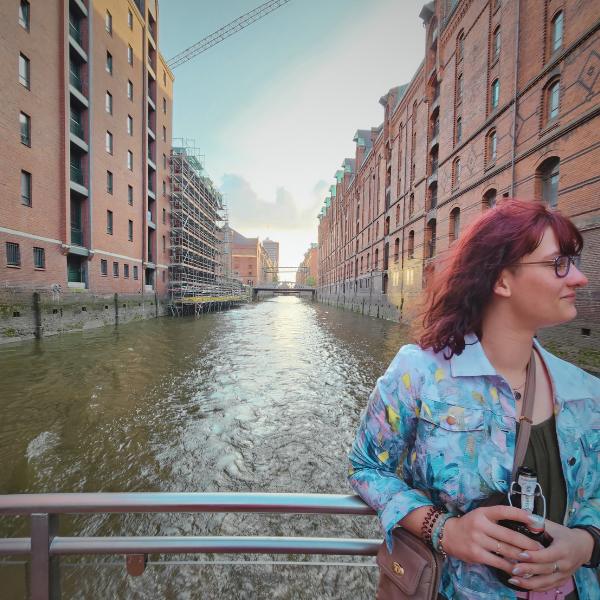 That's me cruising the Hamburg Harbor. The music was right, the beer was cold, the the views were immaculate, and the company was the cherry on top!
That's me cruising the Hamburg Harbor. The music was right, the beer was cold, the the views were immaculate, and the company was the cherry on top!Hamburg Flora
Full of bogs, beaches, rivers, and high humidity, Hamburg is the perfect breeding ground for wildflowers, reeds, deciduous trees and more. Let's see what types of plants Hamburg has to offer in its beautiful coastal areas:
- Birch trees
- Reeds
- Ground ivy
- Yellow archangel
- Annual honesty
- Cuckooflower
- Common mallow
- Maple
- Cherry blossoms

A Strange Must-See
The Boberger sand dunes are a strange area of sand far from the large bodies of water located near the outskirts of the city. They're a vast ecosystem for so many plants and amphibians that you won't see them anywhere in the city.
It's such a unique area, completely sand-covered and surrounded by hiking trails. It's popular among hikers and dog walkers but is generally not a busy spot! Check out this hidden gem!
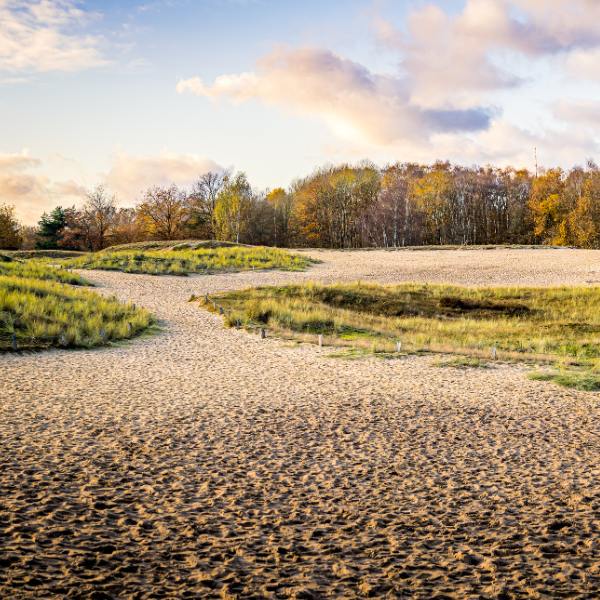 A mysterious adventure! Count me in!
A mysterious adventure! Count me in!Hamburg Fauna
Hamburg's wildlife typically adapts well to the marshy and wetland areas. If you go closer to the North Sea, you could spot some harbor dolphins if you're lucky! Other wildlife you could see:
- Red deer
- Harbor seal
- Grey seal
- Western polecat
- Eurasian otter
- Eurasian beaver
- Water vole
- Blue frogs
- Crane
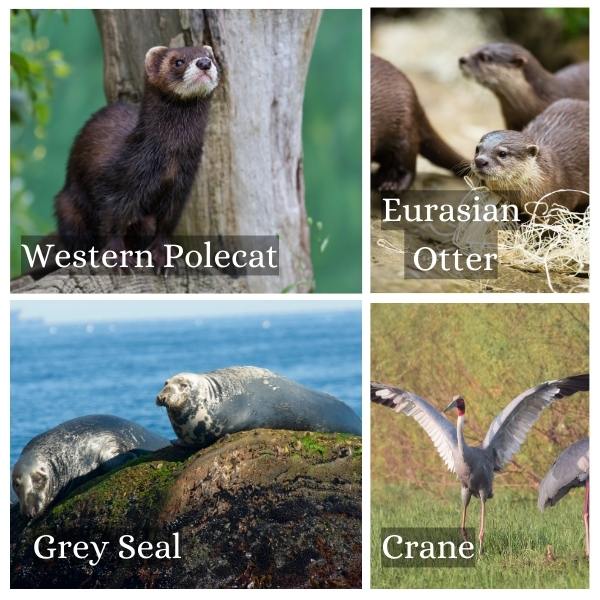
Hamburg Funga
- Orange peel fungus: The name is fitting once you see what they look like...
- Panthercap
- Collared earthstar
- Birch polypore
- Dryad's saddle
- Splitgill mushroom
- Candlesnuff fungus
- Trumpet lichen

Hesse
Hesse (Hessen in German) is home to some major hotspot cities, like Darmstadt and Frankfurt. In Hesse, you can stop by the famous statue of the Brothers Grimm and almost 50 UNESCO World Heritage Sites, including Kellerwald-Edersee National Park, one of the most popular.
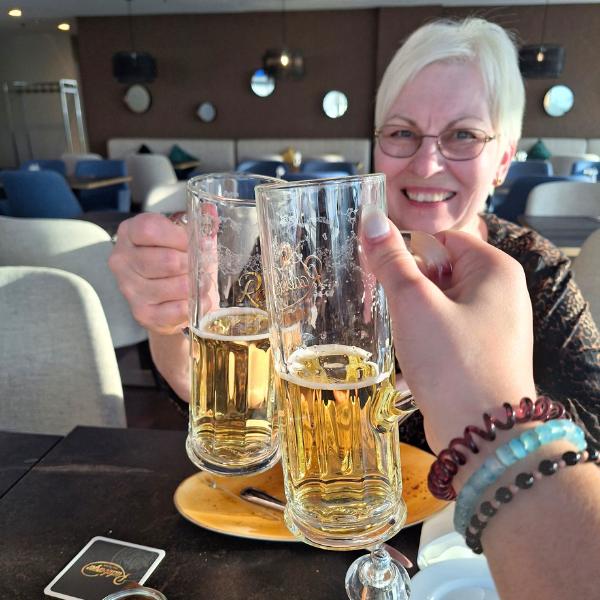 Oma and I sharing a final "Prost! (Cheers), on our last day of the trip, in Frankfurt am Main! A special memory indeed.
Oma and I sharing a final "Prost! (Cheers), on our last day of the trip, in Frankfurt am Main! A special memory indeed.Hesse Flora
Hesse has loads of massive deciduous forests full of oak and especially European beech trees. In the large forests, almost 50% of these trees are over 100 years old! What other plants and flowers love the Hesse environment?
- Sycamore maple
- Dogwood
- Common hazel
- Garlic mustard
- Wild carrot: No, not the edible carrots. This is another name for Queen Anne's lace.
- Black elderberry
- Purple foxglove
- Red stem storksbill

Hesse Fauna
Hesse is known for having an impressive array of birds, with loads of woodpecker species and even more species of bats! Let's find out a few kinds and others that you can see during your time in Hesse:
- Pygmy pipistrelle
- Brown big-eared bat
- Serotine bat
- Great-spotted woodpecker, green woodpecker
- Red kite: No, not the flying toy kind.
- Black stork
- Eagle owl
- Wild boar
- Coypu
Hesse has some rare and rather large mammal species. Sadly, they're rare in this area and on the endangered red list. But they have been spotted around Berlin and Hanau, near Frankfurt. If you see one, respect it with space, and report your sighting.
- Grey wolf
- European wildcat
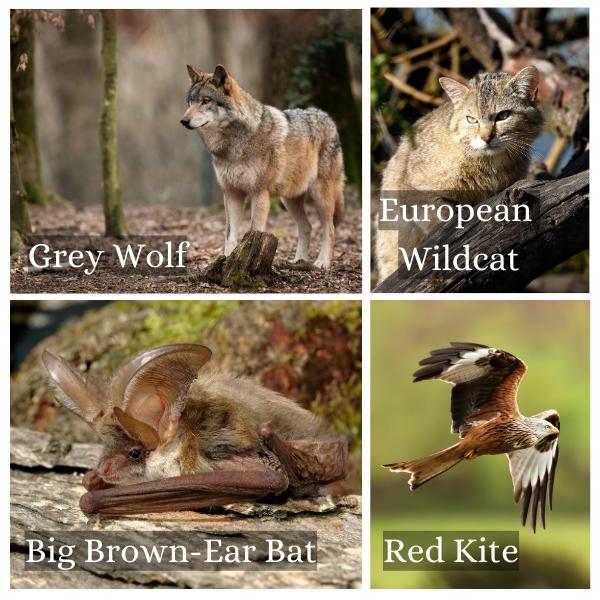
Hesse Funga
Thanks to its massive number of forested areas, Hesse hosts so many mushrooms. Some bright in plain sight, and some hidden in their cozy shaded habitats close by tree roots:
- Red cracking bolete
- Jelly ear
- Porcini
- Parasol
- Chicken of the woods
- Cauliflower mushroom: Wait until you see how accurate this name is!
- Dark honey mush
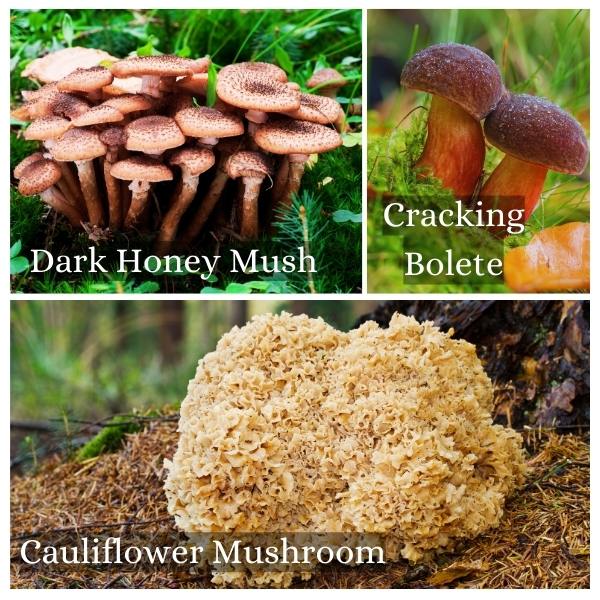
Lower Saxony
Lower Saxony contains 37 districts, consisting of Hannover, Göttingen, Wolfenbüttel, and Aurich, to name a few. The landscapes in Lower Saxony change depending on the area you're in.
When visiting the north, you'll see that it's very flat. It's actually nicknamed the North German Plain. For my fellow Canadians out there, think Saskatchewan. You can drive on the same road and see the other end, but it takes 8 hours to get there!
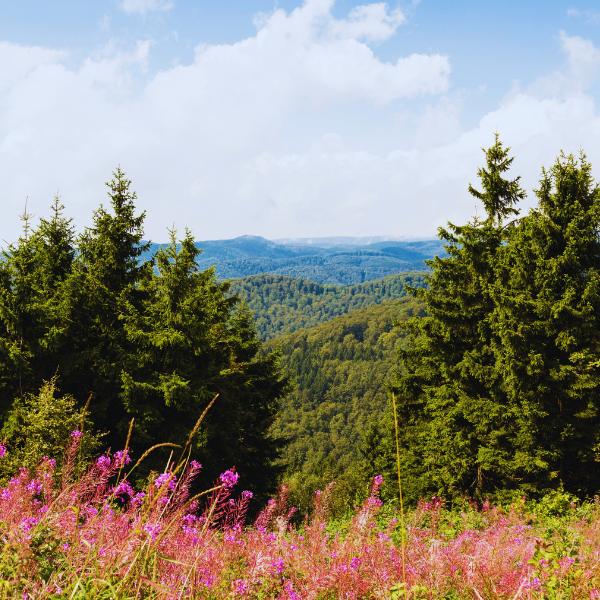 How relaxing is this! Lower Saxony has such diverse landscape. Like these breathtaking Harz Mountains.
How relaxing is this! Lower Saxony has such diverse landscape. Like these breathtaking Harz Mountains.The south, on the other hand, is home to the amazing Harz Mountains and Weser Uplands, meaning alpine plants and animals can be found scattered about - enjoying the incredible landscape.
Lower Saxony Flora
Due to its differences in altitudes and landscapes, Lower Saxony has a multitude of flora. Among this variety are:
- European beech: A common one on our lists so far!
- Silver fir
- Norway spruce: Covers over 80% of the tree population in Lower Saxony.
- Spring vetch, common vetch, tufted vetch
- Woodland/alpine strawberry
- European bramble: Also known as the blackberry, or brambleberry bush.
- Rabbitfoot clover
- Poppies
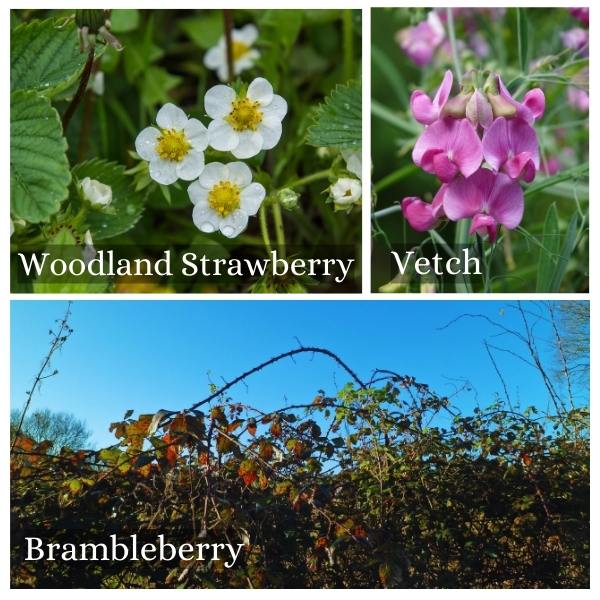
Lower Saxony Fauna
Lower Saxony is the perfect place for wildlife, big and small, to find the ideal habitat. From the north all the way down to the south, here are the critters you could spot:
- A variety of seals: In the Wadden Sea.
- Sea eagles
- Lynx: The beautiful alpine predator thrives in the Harz Mountains.
- Shore crab
- Peregrine falcon: One of the best hunters in the sky!
- Roe deer
- Badger
- Ringed plover
A must-see
Come March and into the late summer months, you can see the cranes of Lower Saxony performing their majestic courtship dances. In the bogs of Diepholzer Moor, a massive area of protected reserves and wetlands, the cranes gather to find a mate for life. This is a sight you don't want to miss. When birds want to impress, they know how to cut loose.

Lower Saxony Funga
- Fly agaric
- Reindeer lichen
- Dyer's polypore
- Earthball
- Black trumpet
- Porcelain mushroom
- Pestle puffball: When you poke them, these guys puff out spores in a plume of "smoke," just like the common puffballs we talked about in Bavaria.
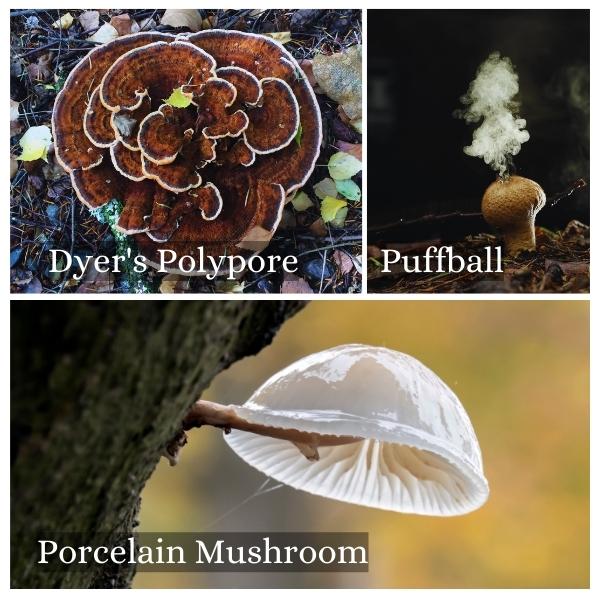
Mecklenburg-Vorpommern
Mecklenburg-Vorpommern is a lake district that is most popular for its water sports and for having one of Germany's largest lakes countrywide, the Müritz. When visiting this state, you have got to try out some sailing, and don't forget to stop by Schwerin Castle! (Schwerin is Mecklenburg-Vorpommern's capital.)
While it hosts over 1000 lakes and drains into the Baltic Sea, the landscape here is mainly flat. Like the north of Lower Saxony, Mecklenburg-Vorpommern is also part of the north German plains.
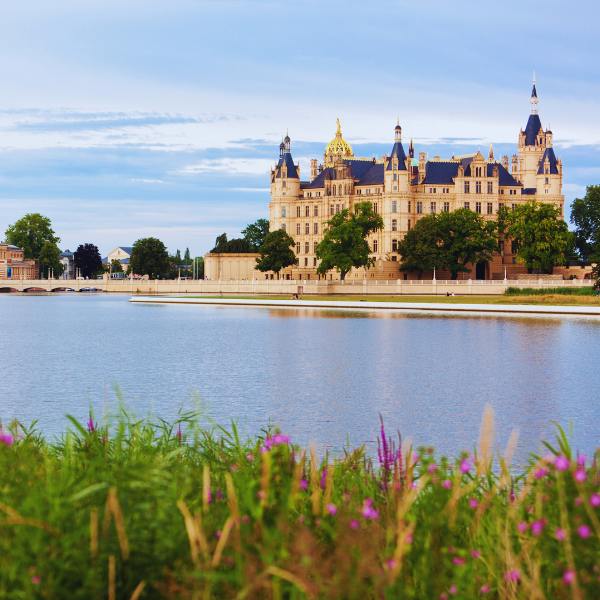 Nothing beats a view like this majestic castle on the horizon
Nothing beats a view like this majestic castle on the horizonMecklenburg-Vorpommern Flora
Along the coasts of its many beaches and lakes, many water-related plants grow. Mecklenburg-Vorpommern is also home to nearly 60% forests and raised bogs. What funky flora are sprouting up here? Let's see:
- Beach grass
- European beech
- Birch
- Lilac
- White sweet cherry
- Poppy
- Cornflower
- Viper's bugloss
- Spiked water milfoil
- Purple clover

Mecklenburg-Vorpommern Fauna
Mecklenburg-Vorpommern is known for its massive wildlife reserves, and if you're lucky, you might spot some of its rare species:
- Golden jackal
- Hedgehog
- Red deer
- Bison
- Red fox
- Wild boar
- White-tailed eagle
- Grey wolf: On the endangered animals list. If you see one, respect it with space and report your sighting!
- Common moon jellyfish

Mecklenburg-Vorpommern Funga
There really are some strange fungi names out there, and Mecklenburg-Vorpommern's collection proves that!
- Tongues of fire
- Moss oysterling
- Olive oysterling
- Witches hat
- Cowboy's handkerchief
- Stinking orange oyster
- Collared parachute
- King bolete
- Yellowfoot

North Rhine-Westphalia
North Rhine-Westphalia, NRW for short, hosts the romantic and breathtaking River Rhine. During our cruise on the Rhine, we got to take in the incredible views of the rows and rows of vineyards, cliffs, rock formations, and vast forests along the way.
 I thought this was just a cool castle until I zoomed into my picture to see the big sign that says "HOTEL"...Gutenfels Castle Hotel, to be exact.
I thought this was just a cool castle until I zoomed into my picture to see the big sign that says "HOTEL"...Gutenfels Castle Hotel, to be exact.North Rhine-Westphalia is home to so many areas of different landscapes and significant attractions:
- Cologne and its famous Cologne Cathedral.
- Sauerland and it's incredible Atta and Dechen Caves ready to be explored.
- The Teutoburg forest and the mysterious giant sandstone pillars of Horn-Bad Meinberg, the Externsteine.
- Monschau and its wildlife trails through rolling hills of blooming daffodils (An indescribable sight!) Especially during the daffodil festivals.
- Eifel and Aachen's iconic and historic mustard mills.
North Rhine-Westphalia Flora
North Rhine-Westphalia has many national and nature parks, including the famous Naturerlebnispark Panarbora in Waldbröl, near Cologne. Here, you can walk along the swaying oak tops on a massive treetop walkway. Take in the views from the observatories and visit the botanical gardens below.
Along with the mighty oak, one can also see many of these species around North Rhine-Westphalia:
- European beech
- Copper beech: Also commonly known as purple beech.
- Elm
- Birch
- Creeping buttercup
- Yarrow
- Cornflower
- Daffodil
- Dhalia
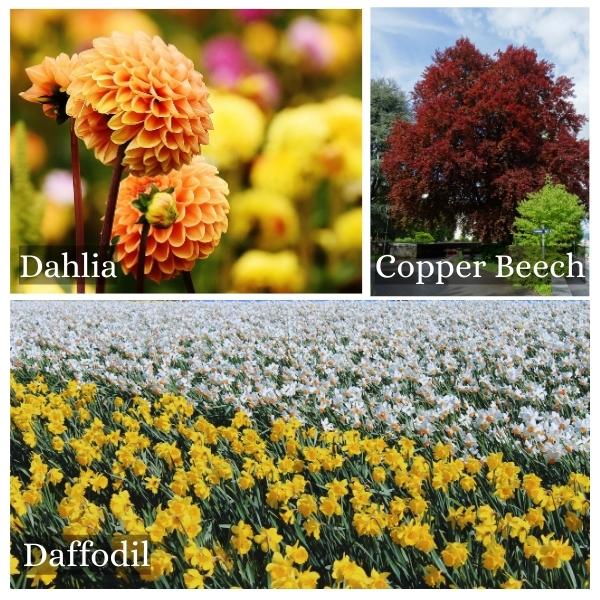
North Rhine-Westphalia Fauna
North Rhine-Westphalia is known for having some of the most diverse wild animal species in northern Germany. Not only because of its flamingos but also because there are so many other species to be recognized. From the peat bogs to the 'calm brown beasts' of Bad Berleburg, here are the animals you can see throughout NRW:
- Flamingos
- European bison: The calm brown beasts, in Wittgenstein.
- Linx
- Storks: Thriving in the great peat bogs.
- Wild boar
- Wild horses: Commonly spotted in Westmünsterland. What a fairytale sighting that would be!
- Over 500 butterfly species, including the Red Admiral and the Peacock Butterfly: Head to the Weser-Skywalk on the Hannover cliffs, where colonies of thousands swarm the cliff faces.
- Rose-ringed parakeet: A bright green parakeet with a red ring around the neck.

A Must-See
Well known for its bird-watching groups and excursions, especially in Zwillbrocker Venn, Münsterland. If you find yourselves wandering along these wetlands from March, and sometimes into September, you can see the wild flamingos!
No, these beautiful pink birds aren't only a tropical species, and they've made these wetlands their chosen breeding ground, making them one of the only Flamingo colonies in all of Europe.
North Rhine-Westphalia Funga
- Jelly ear
- Chicken of the woods
- Fly agaric
- Giant stinkhorn
- Amethyst deceiver
- Cauliflower mushroom
- Porcini
- Beefsteak fungus

Rhineland-Palatinate
This Western German state of Rhineland-Palatinate, shares the lovely Rhine River, and the Moselle River. It is also home to the famous UNESCO World Heritage Site, the Upper Middle Rhine Valley.
Rhineland is covered in forests and, like NRW, is a popular wine destination. Driving down the winding roads, one could almost lose track of how many vineyards are climbing up the hills!
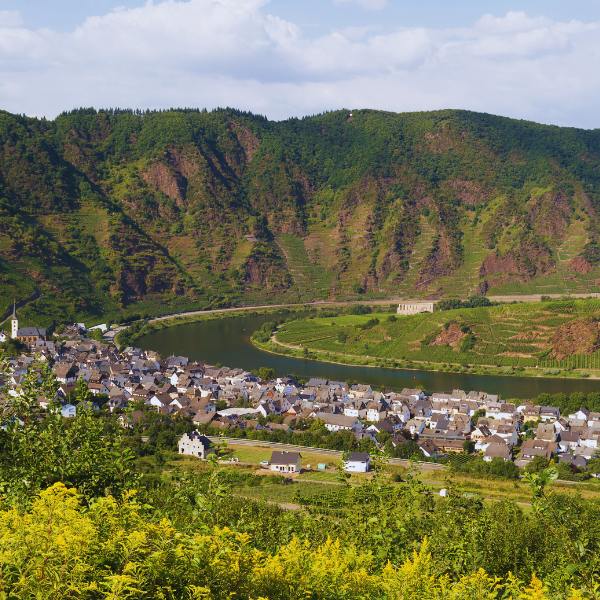 The serene scene of the Havel River is here to bring you a bit of peace before hearing the crazy funga names below..
The serene scene of the Havel River is here to bring you a bit of peace before hearing the crazy funga names below..Rhineland-Palatinate Flora
- Blackthorn
- European beech
- Corn flower
- Germander speedwell
- Red deadnettle
- Tansy
- Toadflax
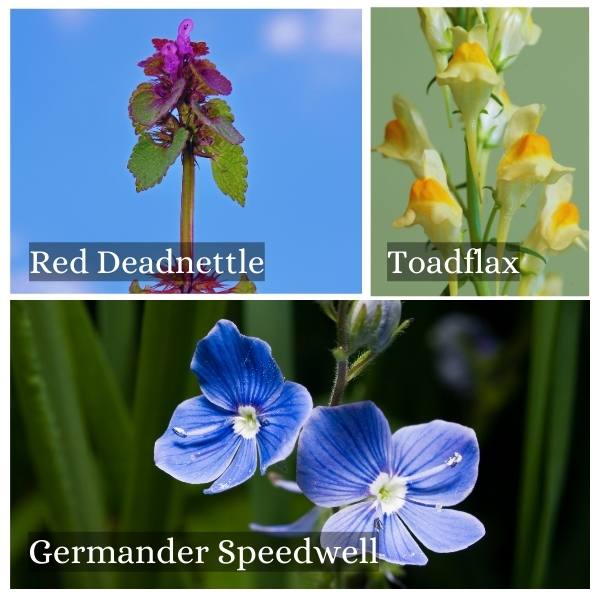
Rhineland-Palatinate Fauna
- Red fox
- North chamois: A species of goat-antelope, and if you look closely among the mountainous vineyards, you can grab an unforgettable picture of this beautiful animal.
- European badger
- Brown hare
- Wild boar
- Pine marten
- Wild horses
- Mouflon
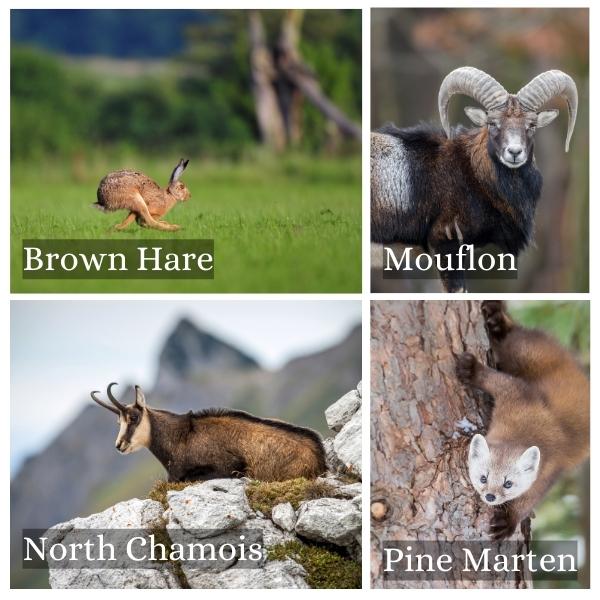
Rhineland-Palatinate Funga
Introducing even more weird names! Whenever I read "Chicken of the woods," I either think of a cute children's book title or a funky indie folk song; there's no in-between...
- Poor man's licorice
- Devil's fingers: Personally, after seeing a picture of these, I think calamari or burnt Cheetos. Just me?
- Chicken of the woods
- Magpie inkcap
- Jelly antler
- Fly agaric
- False deathcap

Saarland
Saarland is a very small state, which makes it the perfect spot for unique nature. Massive valleys scattered throughout Saarland have been untouched and inhabited for years, allowing many forested areas to grow and thrive.
Don't forget to visit the famous bend in the Saar River at the Baumwipfelpfad, which has a treetop view!
 Baumwipfelpfad is on my to-do list next time I go to Germany for sure!
Baumwipfelpfad is on my to-do list next time I go to Germany for sure!Saarland Flora
- Silver birch
- Sycamore maple
- European holly
- Snow-in-summer
- Poppies
- Wild oregano
- Snowdrop
- Purple foxglove
- Military orchid
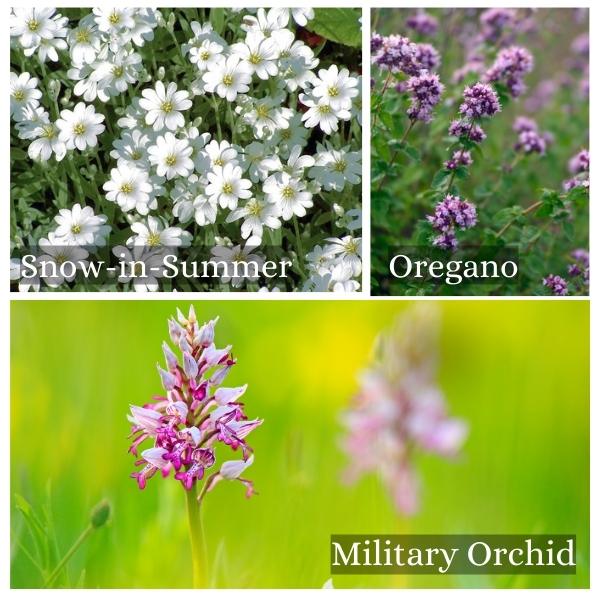
Saarland Fauna
- Alpine marmot
- Lynx
- Grey wolf
- Eurasian otter
- Great egret
- Badger
- European dormouse: Often confused for a small squirrel with their bushy tails.
- Mouse eared bat
- Greater horseshoe bat
- Wild cat: They look very similar to a regular house cat, but slightly larger, and much more aggressive. These guys live for the hunt.

Saarland Funga
- Fly agaric
- Jelly antler
- Sunburst lichen
- Hair ice fungus: This is one of the strangest ones yet.
- Sulphur tuft
- Violet webcap
- Funnel
- Splitgill mushroom
- Porcini

Saxony
Saxony is a hotspot for extreme sports enthusiasts. One can enjoy paragliding, hot-air ballooning, mountain biking, and more! But if that's not your speed, and you prefer to be well ... on the ground, there are an abundance of hiking trails and beautiful sights to see here, including the Zittau Mountains and the historic capital city of Dresden.
 That's me doing my famous pose in Dresden's city center. It was hot this day! But Dresden is definitely on my go-back list.
That's me doing my famous pose in Dresden's city center. It was hot this day! But Dresden is definitely on my go-back list.Saxony Flora
- Norway spruce
- Scotts pine
- Spring vetch
- Crimson clover
- Sweet cherry
- Dog rose
- Marsh labrador tea
- Great burnet

Saxony Fauna
- European bee-eater
- Eurasian elk: A species of moose that used to roam Germany in groups of hundreds, is now a little rare to spot. But if you're going to spot them anywhere, Saxony is one of the best spots!
- Wild boar
- Hedgehog
- Grey wolf
- Great egret
- Grey heron
- Fire bellied toad
- Eurasian beaver

Saxony Funga
- Velvet-footed pax
- Witches butter
- Tripe fungus
- Oyster mushroom
- Golden pholiota
- Beefsteak polypore
- Collared earthstar
- Brown roll-rim

Saxony-Anhalt
Saxony-Anhalt is one of Germany's states with the most UNESCO World Heritage Sites, including the largest English park in Europe, the gardens of Dessau-Wörlitz. Attention asparagus lovers! Did you know that Saxony-Anhalt is one of the best places to get the famous German white asparagus?
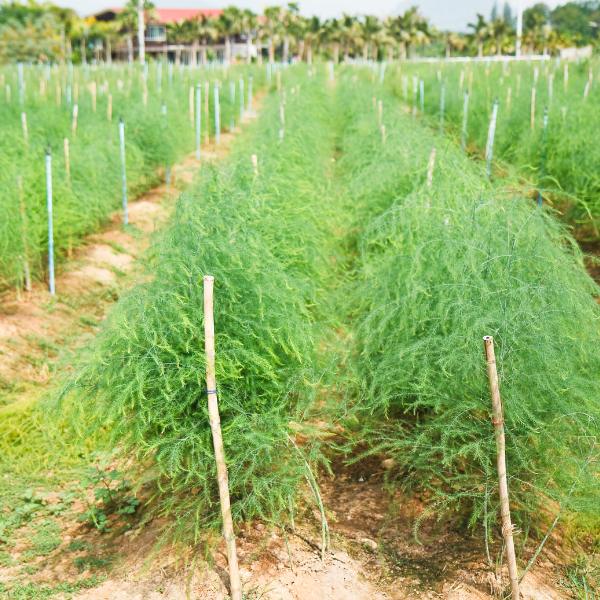
Saxony Anhalt Flora
- Poppies
- Fly orchid
- Lady orchid
- Cream scabious
- Heathers
- Norway maple
- Oak
- Common yew

Saxony-Anhalt Fauna
Saxony-Anhalt is a bird-watching hotspot in Germany! Keep your eyes on the skies, but also watch your step! There are loads of weasel species, mice, and hedgehogs roaming about.
- European water vole
- Coypu
- Lesser horseshoe bat
- Least weasel
- European fat dormouse: Yep, you read that right. Think the dormouse from Saarland, but... a little chubbier.
- Red fox
- Great crested grebe
- Eurasian jay
- Hedgehog
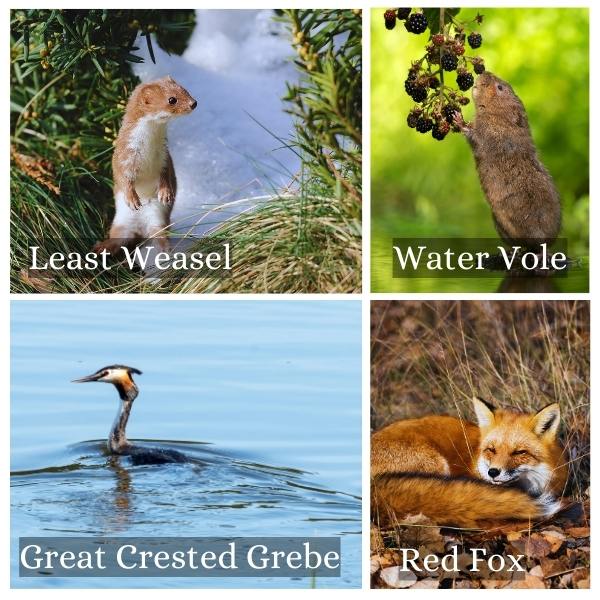
Saxony-Anhalt Funga
- Giant puffball: These can grow to be absolutely massive, up to 20 inches. In some cases, these can reach up to 60 inches!
- Dryad's saddle
- Saffron milkcap
- Chicken of the woods
- Stinking orange oyster
- White dapperling
- Tripe fungus
- Fairy ring marasmius: These are typically found surrounding the base of a tree trunk, or perhaps you've seen these come up in a circle in your yard. These are known as the fairy rings.

Schleswig-Holstein
Schleswig-Holstein sits right at the top of Germany on the map, with its western parts bordering the North Sea. Just a few of the many cities in Schleswig-Holstein include: Kiel, Ratzeburg, Neumünster, and Lübeck.
On our tour through Germany, Lübeck was one of my favorite stops. It's where I discovered my new favorite donut shop, Royal Donuts. Thanks to this donut, I made it my mission to go to as many Royal Donuts as I could on the tour, and I ended up visiting five different ones in different states across Germany. Alright, enough about donuts. Let's dive into some flora, fauna, and funga!
 This was my favorite of all of the royal donuts I had. It's a white chocolate (which is my favorite), covered, cream-filled strawberry donut, topped with an adorable Kinder Beuno hippo!
This was my favorite of all of the royal donuts I had. It's a white chocolate (which is my favorite), covered, cream-filled strawberry donut, topped with an adorable Kinder Beuno hippo!Schleswig-Holstein Flora
Being so surrounded by water, Schleswig-Holstein hosts an abundance of sea plants that can't be found in the middle states of Germany.
- European beech
- Sea sandwort
- Sea buck-thorn
- Biting stonecrop
- Sea kale
- Ragged-robin
- European sea rocket
- Sand sedge
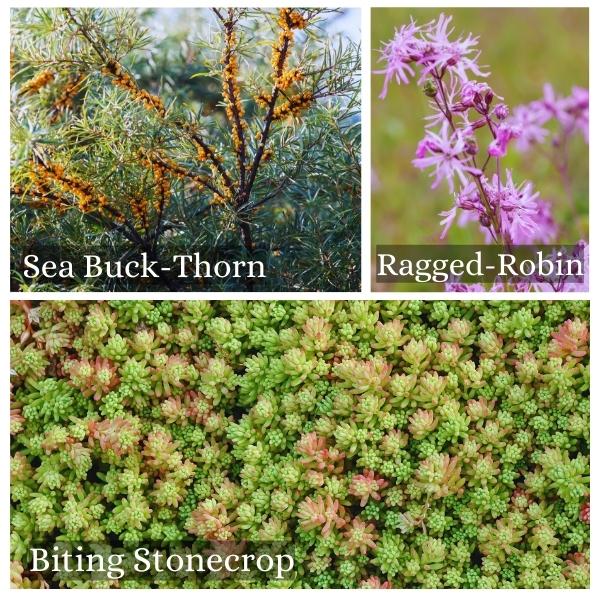
Schleswig-Holstein Fauna
- Grey seal
- Harbor seal
- Bottlenose dolphin
- Eurasian water shrew
- Western polecat
- Greater rhea
- Muskrat
- Roe deer
- Stone marten
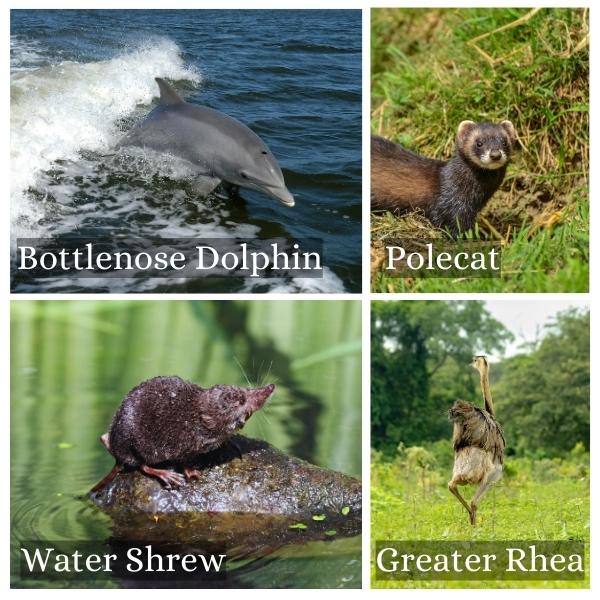
Schleswig-Holstein Funga
- Turkey tail
- Fly agaric
- Garlic parachute
- White saddle
- Crimped gill
- Rosy bonnet
- Pinkgill, blue pinkgill
- Aniseed funnel
- Bitter oyster

Thuringia
Also known as the "Green Heart of Germany" due to its densely forested areas. In the heart of Thuringia lies Eisenach, the home of Wartburg Castle , Jena, Erfurt (the state capital), and Weimar.
Thuringia is the birthplace of many famous Germans and the home of big events in history, including the place where Martin Luther translated the Bible. It also hosts the Feengrotten and its breathtaking grottoes.
 That's me on our short stop through Weimar. I can't even count the number of cute book stores I went in here!
That's me on our short stop through Weimar. I can't even count the number of cute book stores I went in here!Thuringia Flora
- Sycamore maple
- Oak
- Wood anemone
- Star gentian
- Cowslip
- Colt's foot
- Spring vetch
- Carthusian pink
- Lizard orchid
- Meadow crane's bill

Thuringia Fauna
- Red kite
- Eurasian lynx
- European mouflons
- Kestrel
- Western roe deer
- Wild boar
- Grass snakes
- Particoloured bat
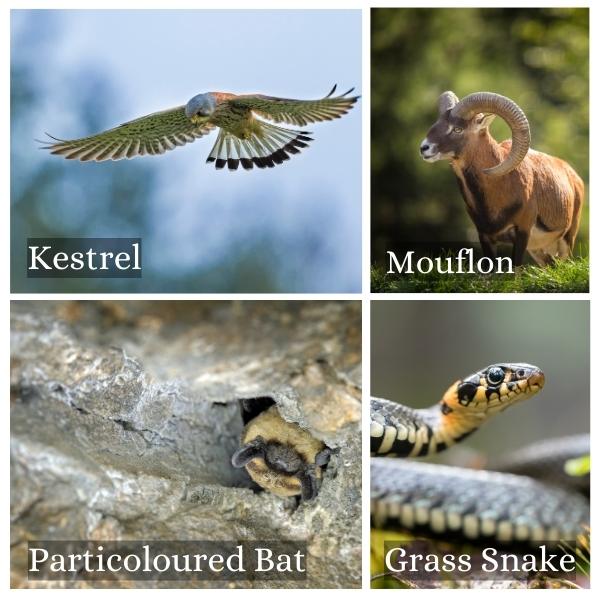
Thuringia Funga
- Candlesnuff fungus
- Fly agaric
- Honey mushroom
- Saffron milk cap mushroom
- Penny bun bolete
- Amethyst deceiver
- Shaggy mane
- Porcini
- Oak moss
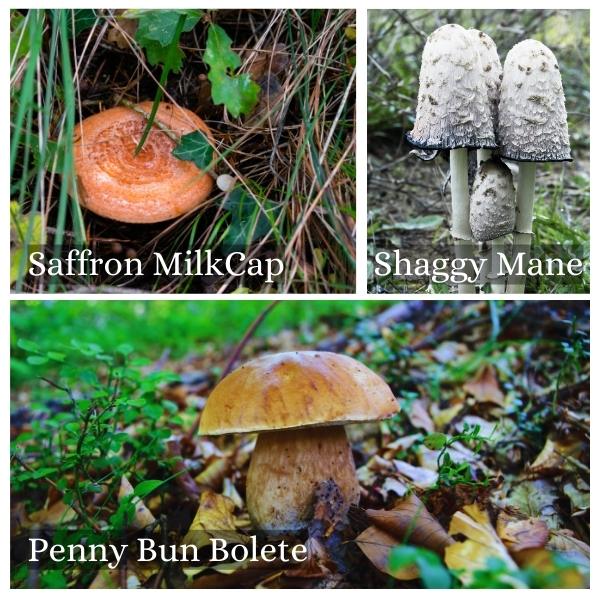
Mushrooms Worth Foraging
Foraging is a big gig in Germany, and autumn is the peak foraging time. Especially in places like Saxony, Berlin and the Tegel forest, and Brandenburg's pine forests. If you're just looking to collect them, you don't need to check their edibility, but keep in mind that some are dangerous to touch!
What are the common and best mushrooms to forage for? Grab your mushroom-collecting basket and let's go picking! But first, mushroom legalities incoming.
Disclaimer:
I am not a mushroom foraging expert. Please take your foraged mushrooms to the local Pilzberatungsstellen (Mushroom Advisory Center) where they will check your haul to make sure you don't have any poisonous ones in your basket. These centers are throughout Germany to make sure you can safely enjoy your mushrooms.
We, at Tour My Germany, will not be held liable for using the below information for anything other than informational and educational purposes. It does not constitute professional advice.

- Birch mushrooms
- Chanterelles: A popular foraging mushroom. Easy to identify and yummy!
- Enoki: Flavorful and used around the world for cuisine.
- Cauliflower mushroom: Not a desirable taste, but edible.
- King bolete: Considered one of the most flavorful and nutrient packed mushies!
- Bay bolete: When properly prepared, it can be eaten.
- Parasol mushrooms: When properly identified.
- Jelly ear: Described as having not much flavor, but they're commonly eaten.
- Common stinkhorn: When properly prepared, it can be eaten.
- Puffball: Only edible when young (meaning pure white on the inside) and could be easily misidentified as the dangerous deathcap. Do your research before picking these guys. Instead, spend some time poking any puffballs you see to help spread them!
That's a Wrap Folks
That's a wrap on our tour through the lists of Germany's flora, fauna, and funga. Did you learn something new? I know I sure did. Especially with those weird mushrooms names! A few of them had me laughing pretty hard. Chicken in the woods... I mean, who came up with that :)
Thanks for reading and exploring the plants and animals of Germany. From one nature lover to another, find something new and nifty and go have some new adventures!
 I love rock collecting, and this was one of my favorite finds
I love rock collecting, and this was one of my favorite finds

